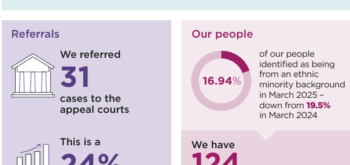[contextly_auto_sidebar]

‘Panic’ figure by Isobel Williams – from Proof magazine, issue 1
‘After all, what is a fine lie? Simply that which is its own evidence.’
Oscar Wilde, The Decay of Lying (1891)
The present preoccupation with sex crime and victims of crime has given rise to a new type of victim: the falsely accused. These victims rarely receive the attention from policy-makers that they deserve, although the collapse of some recent high profile investigations into allegations of historic abuse has belatedly prompted a more sceptical approach to some complainants. I believe that victims of false accusations now deserve more consideration.
Even a nascent rebellion against the fashionable ideology of ‘believe the victim [of sexual abuse]’ supported by former DPP Keir Starmer QC is out of step with current CPS practice (Human rights, victims and the prosecution of crime in the 21st century, (2014) Crim LR 777, 782). A Manchester barrister who prosecutes allegations of sexual assault for the CPS was recently quoted as saying: ‘Rape has become the bread and butter of the CPS. Basically if someone complains, we prosecute.
Various victims of false accusations, of whom the most high profile and outspoken is the well-known BBC radio presenter Paul Gambaccini, have voiced dismay at the authorities’ willingness to entertain complaints that in the past would have been seen as outlandish, even vexatious.
Modern Gothic
Perhaps the most extreme example of fantasy at work is Operation Midland, looking into allegations of alleged VIP abuse centring on a Westminster apartment block popular among MPs: Dolphin Square. This exercise, which cost the public purse £1.8 million in police staffing costs alone (here), was prompted by sensational reports on an online news source named Exaro.
Its star witness is an anonymous accuser, whose multiple personalities include Nick, Carl “Survivor” and Stephen. He claims to have witnessed a number of murders, and attempted genital mutilation, as well as being repeatedly assaulted himself by his army step-father and various MPs and other dignitaries, including the former Home Secretary, Sir Leon Brittan. In November 2014, Detective Superintendent McDonald, who led the Metropolitan Police inquiry into Nick/ Exaro’s claims, called them ‘credible and true’.
Professor Jenkins, an eminent historian, has patiently explained that the evidence for Nick’s claims has been weak to non-existent. In two recent articles for The American Conservative (here and here), he points out that, conspiracy theories about a dastardly group of child-raping, boy-murdering VIPs is a rehash of 1980s scare-mongering:
‘The “elite paedophilia” charges circulated very widely in tabloid media of the 1980s, usually in the context of lunatic theories of Satanism and supposed “ritual child abuse,” sometimes linked to anti-Masonic hysteria. Then as now, these fevered rumors named names, including cabinet members and members of the royal family, as well as prominent Jews, like Brittan himself.’
Why are such preposterous tales taken so seriously today? Jenkins argues that this is because those hearing them have an ideological need to believe in a litany of horrors: ‘When I say that X is “credible”, what we mean is that I find what he has to say believable, and that fact depends as much on my willingness to accept his statement as on any quality in his character or demeanor.’
Yet Sir Keir Starmer and the present DPP Alison Saunders have both popularized the idea that it is possible, indeed desirable, to separate the credibility of an allegation from the credibility of its maker.
11 ways to falsity
It’s time for a much more rigorous and open discussion about why some people – whom we should call ‘pseudovictims’ – make false allegations. But first I should clarify what is meant by ‘false’. The word is ambiguous, covering a spectrum of claims that are simply unfounded, to those that are mistaken, to those that are dishonest.
In their 2012 paper, Jessica Engle and William O’Donoghue proposed 11 pathways to false allegations of sexual assault. These are:
- Lying;
- Implied consent;
- False memories;
- Intoxication;
- Antisocial personality disorder;
- Borderline personality disorder;
- Histrionic personality disorder;
- Delirium;
- Psychotic disorders;
- Dissociation; and
- Intellectual disability.
Crucially, they omit the honest but mistaken person: Pathway 12. A classic example of this is the rape victim who misidentifies her assailant in an identity parade.
People may lie about sexual assaults for a variety of motives: to inflict harm on the accused and his family; as revenge for some perceived slight or failure; for monetary gain; to get out of trouble; to explain a pregnancy; to gain the upper hand in a custody dispute, or to fit in with a group that is making accusations against a particular person or institution (the ‘bandwagon effect’).
Engle and O’Donoghue call these secondary gains. It should also be recognized that people who start by lying may come to believe in their own stories.
Confusion over consent
Another problem has emerged as a result of the redefining of what is meant by consent. Many feminists – especially those at universities – have campaigned for the introduction of ‘affirmative consent’ policies, which place the responsibility on male partners to obtain consent to every stage of a sexual encounter. In San Francisco last autumn, one health educator told a class of 16 year-olds that they should obtain consent every ten minutes.
This excessively prescriptive approach may cause some young people to redefine an encounter as non-consensual, with the benefit of hindsight. What they do not understand is that their behaviour could plausibly be interpreted as consensual at the time. What does not help is if others, who are consulted, become obsessed with trying to establish if the scenario amounts to a rape case.
The intoxication of both or one party to a sexual encounter can create particular difficulties. Alcohol and other drugs can disinhibit; they can also create cognitive distortions, memory gaps and blackouts. Persons recovering from a drugged state may confabulate to fill in memory gaps and develop a narrative of what they think ‘must have’ occurred.
People can also develop false memories of abuse, for example as a result of contact with therapists, pressure from peers or from significant others (such as partners or parents), or even from reading stories in the media. There is not space here to discuss this important topic in detail.
Mental disorder
It is a sad fact that those with mental disorders or learning disabilities are disproportionately vulnerable to sexual assault. But it should also be recognized that third parties – such as care providers – may stand to benefit from a false allegation.
That mental problems could potentially lead to false allegations is rarely discussed. But it is a very serious issue, which would benefit from wider debate. Those with personality disorders may be motivated to make false accusations out of motives of revenge, or attention-seeking. Some may misperceive non-sexual events as sexual. Those who are delusional may also make false accusations of sexual misconduct.
Those who are learning disabled may innocently make sexualized comments, which may be seized on by those caring for them as a sign of abuse. They are highly suggestible.
The power of story-telling
In my opinion, far too little attention has been paid to the lure of the victim narrative, and the rewards of victimhood (for those who are competent). These rewards can include the sympathy and attention which those proclaiming to be victims can expect, and the seduction of the ‘truthful lie’, both for its narrator and its audience.
Those who confabulate about their past experience so as to come to terms with it may be expressing an emotional truth (such as a perception of a violation of the self), but an actual lie. As the psychologist Professor Janice Haaken acknowledges:
‘The art of storytelling is not based merely on chronicling a sequence of facts but on the artful juxtaposition of dramatic elements. The power of the story to stir others…depends on its felt truth and plausibility rather than on its mere facticity… . This may be the age of testimonial, as Elie Wiesel suggests, but testifiers do not inevitably speak the truth, as virtuous as they may perceive themselves to be.’
Professor Janice Haaken, Pillar of Salt: Gender, Memory and the Perils of Looking Back (Rutgers University Press, 1998)
The VIP-accuser Nick seems to be an epic storyteller. The fact that the highest echelons of the UK’s police fell for his tall tales is surely a tribute to his narrative powers. Whilst he may indeed have been a victim of some form of sexual abuse, his story seems to have taken on a life of its own. I am convinced that others have played a part in the creation of his Gothic tableaux. The deconstruction of this remarkable episode will no doubt occupy researchers and journalists for much time to come.
This article originally appeared in The Barrister magazine here






